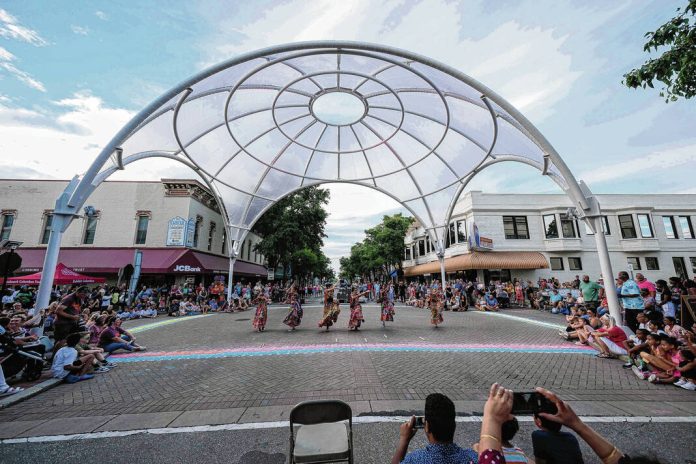Call it a case of dome sweet dome.
InterOculus, the popular, hard-to-miss, often colorfully illuminated crowning creation at Fourth and Washington streets in downtown Columbus, is staying put.
City officials made that official at Tuesday’s Board of Public Works meeting at City Hall. The nonprofit Landmark Columbus Foundation oversees the Exhibit Columbus architectural exhibition, from which the originally temporary piece arose.
The exhibition, “Public By Design,” ran Aug. 25 to Sunday.
Landmark Columbus now has donated the partially steel edifice to the city, according to an agreement that was unanimous at the meeting.
And the city also approved a separate motion Tuesday to accept a three-year agreement for the local Ovation Technology Group to maintain the piece’s four colored lights — and the operation of them — at the group’s expense. McCoy called that effort “a five-figure” in-kind donation.
The Miller Prize installation, designed primarily by architect Vishaan Chakrabarti of New York City’s Practice for Architecture and Urbanism, immediately became a community gathering place when Exhibit Columbus hosted a street dance Aug. 26 underneath the work. The event attracted a pluralistic, partying throng representing a blending of the city’s rich, ethnic diversity.
“We at PAU are thrilled that the Columbus community made the decision to keep InterOculus well beyond its original time frame,” Chakrabarti said from his New York office. “This popular embrace is proof that community-based, connective design is meaningful to people’s lives.
“We hope InterOculus long contributes to the city’s public life and helps, alongside other steps, to revitalize downtown.”
Soon after the opening of the exhibition, “Public By Design,” local residents began asking if the popular piece might stay.
“They keyed in on that pretty quickly,” McCoy said.
Such inquiries only increased recently after the local Ovation Technology Group improved the lenses and the software that light the piece.
“I just want to express how incredibly grateful we are to the city, and to Ovation Technology Group,” McCoy said at the meeting.
Mayor Jim Lienhoop asked McCoy briefly if some residents’ early concern about birds roosting on InterOculus ever had materialized. McCoy responded that such never happened, and didn’t warrant any future concern since most roosting birds downtown seemed to prefer business awnings downtown.
“It’s actually been a bit of a bird deterrent,” McCoy said.
Dave Hayward, executive director of public works, said that InterOculus’ maintenance would include an annual inspection.
Another Miller Prize Exhibit Columbus temporary installation now turned into a permanent one is PORT’s The Plot Project, forming an arc around Mill Race Center at Mill Race Park.
The 1,250-foot arc is subdivided into 12 plots that serve as testing beds for landscape rewilding experiments that have been grown over the course of a nine-month growing season. Some plots are left unmown to grow feral, while others are prepped and over-seeded with mixes of native warm-season grasses. Bands of wildflowers, which were seeded with a mix of native and naturalized annuals and perennials, highlight the transition between plots.
The installation includes brightly colored pavilions for relaxing near the center. The piece won strong public praise at a recent Miller Prize Conversation event for further beautifying the park.
In other Exhibit Columbus news, the High School Design Team’s installation, Machi, near Sixth and Washington streets, will be moved to a permanent location in a Martinsville park, according to McCoy. The piece is expected to be moved on Friday.
The installation contains movable chairs, tables, and more that allow every person to customize their own gathering space as they imagine it to be. Machi also integrates a multi-level canopy that grants opportunities for making art, taking selfies, or gathering under shade. The overall goal of Machi was to make a space that feels welcoming and secure for all, according to the students who created it.





